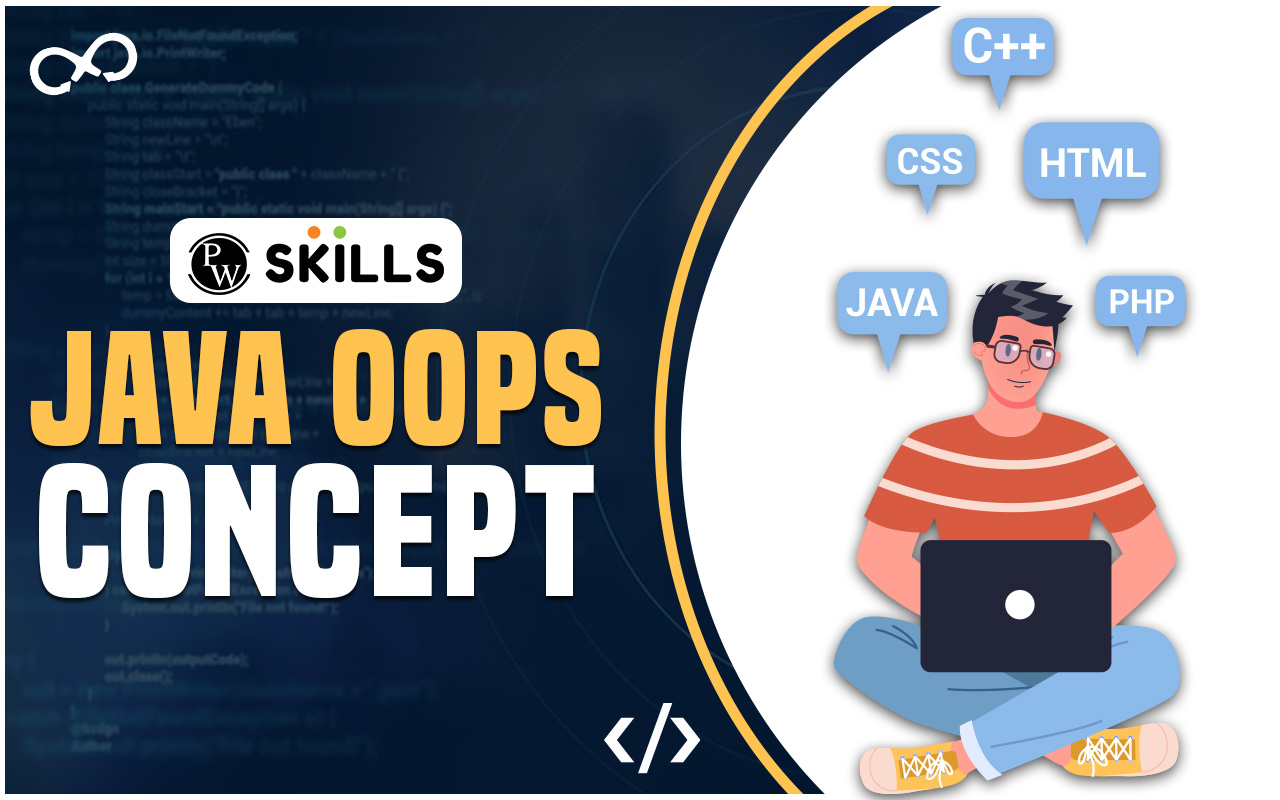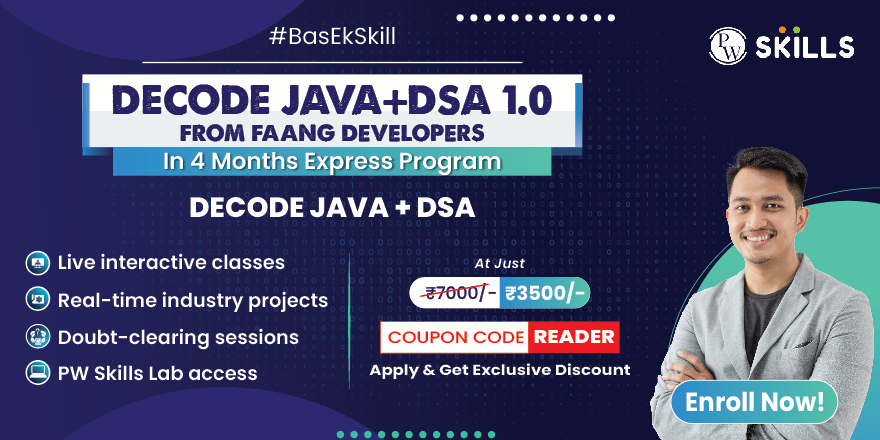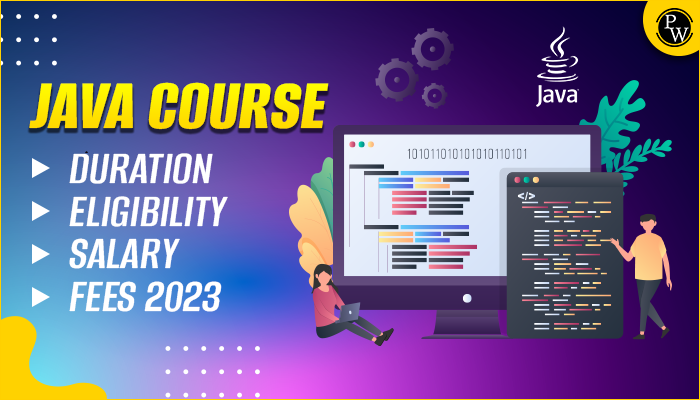Mastering OOPS Concepts in Java is crucial for building strong and effective applications. Learn the essentials of object-oriented programming and discover how they enhance Java coding in 2024!
OOPS Concepts in Java: Object-Oriented Programming System (OOPS) in Java revolves around four key principles known as the OOPS concepts in JAVA. Encapsulation involves bundling data and methods into a single unit, promoting data hiding. Inheritance allows a class to inherit properties and behaviours from another, fostering code reusability.
Polymorphism enables objects to take on multiple forms, allowing flexibility in method invocation. Abstraction simplifies intricate systems by creating models of classes from real-world things. It highlights crucial aspects and conceals unnecessary details.
These OOPS concepts in Java collectively form the foundation of Java programming, facilitating modular, maintainable, and extensible code development.
If you want to become a highly-paid web developer, then PhysicsWallah’s Full Stack Web Development course is just what you need for success! Our course will teach you everything from basics to advanced to make sure that you stay ahead of your competition and bag a high-paying job! So, don’t wait! Enroll now and use coupon code – READER for an exclusive discount!
Also read: Object Oriented Programming In Java Specialization, Java OOP Tutorial
What Are the OOPS Concepts in Java?
OOP organises software into objects, each symbolising a real-world entity or idea. Java’s design relies on OOP, embodying four key principles: Encapsulation, Inheritance, Polymorphism, and Abstraction.
- Encapsulation: Encapsulation involves bundling data (attributes) and methods (functions) that operate on the data into a single unit, known as a class. This unit restricts access to some of its components, providing a protective barrier that prevents the accidental modification of data. The outside world interacts with the class through a well-defined interface, promoting data security and code maintainability.
- Inheritance: Inheritance is a mechanism that allows a class (subclass or child class) to inherit properties and behaviours from another class (superclass or parent class). This promotes code reusability, as common functionalities can be defined in a base class and shared among derived classes. In Java, the “extends” keyword is used to establish inheritance relationships between classes.
- Polymorphism: Polymorphism means “many forms” and is a concept that allows objects to take on multiple forms. In Java, polymorphism is accomplished by using method overloading and method overriding. Method overloading means creating several methods with the same name but different parameters. In contrast, method overriding allows a subclass to provide a specific implementation of a method defined in its superclass. This flexibility simplifies code design and supports dynamic method invocation.
- Abstraction: Abstraction involves simplifying complex systems by modelling classes based on real-world entities and focusing on essential features while hiding unnecessary details. Abstract classes and interfaces in Java are key components of abstraction. Abstract classes provide a blueprint for other classes and can contain both abstract (unimplemented) and concrete (implemented) methods. Interfaces define a contract for classes to implement, promoting a standardised way to interact with diverse objects.
- Coupling: Coupling refers to the knowledge or information or dependency of another class. It arises when classes are aware of each other. If a class has the detailed information of another class, there is strong coupling. In Java, we use private, protected, and public modifiers to display the visibility level of a class, method, and field. You can use interfaces for the weaker coupling because there is no concrete implementation.
- Cohesion: Cohesion refers to the level of a component that performs a single well-defined task. A single well-defined task is done by a highly cohesive method. The weakly cohesive method will split the task into separate parts. The java.io package is highly cohesive because it has I/O related classes and interface. However, the java.util package is a weakly cohesive package because it has unrelated classes and interfaces.
- Association: Association represents the relationship between the objects. Here, one object can be associated with one object or many objects. There can be four types of association between the objects:
- One to One
- One to Many
- Many to One, and
- Many to Many
Let’s understand the relationship with real-time examples. For example, One country can have one prime minister (one-to-one), and a prime minister can have many ministers (one to many). Also, many MP’s can have one prime minister (many to one), and many ministers can have many departments (many to many).
- Aggregation: Aggregation is a method to attain Association. It shows the connection where one object holds other objects as a part of its condition. It reflects a not-so-strong relationship between objects. In Java, it is also called a has-a relationship, similar to how inheritance shows the is-a relationship. It provides another way to recycle objects.
- Composition: Composition is also a method to achieve Association. Composition illustrates the connection where one object holds other objects as a part of its condition. There exists a robust relationship between the holding object and the dependent object. It is a situation where holding objects cannot exist independently. If you remove the main object, all the associated objects will be automatically removed.
Recommended Technical Course
- Full Stack Web Development Course
- Generative AI Course
- DSA C++ Course
- Java+DSA 1.0 Course
- Data Analytics Course
- Data Science with ML 1.0 Course
Why is it Called an Object-Oriented Programming Language?
The most commonly used OOP languages are based on classes, signifying that objects are examples of classes, which also define their types. The terms “objects” and “oriented” were first employed in the modern sense of object-oriented programming.
Java stands out as the widely embraced pure object-oriented language. Developed by Sun Microsystems, it served as a control language for small appliances. It was well-suited for use with many languages that allow object orientation. PASCAL has transformed into the object-oriented DELPHI. C supports object orientation without making it mandatory.
Not all techniques and structures associated with object-oriented programming are directly supported in languages claiming OOP support. It performs operations on numbers. The features mentioned below are typical in languages supporting object-oriented programming.
Languages with the majority of object features are original. Oberon or Oberon-2 are examples. It is possible to use abstract data type support in languages that do not have all of the features of object-orientation. object-orientation. This also includes prototype-based languages. prototype-based languages. Javascript, Lua, and CLU are examples.
Also read: Full Form of OOPS: Applications, Advantages, Future Trends
Difference Between Procedural and Object-Oriented Programming
Procedural and object-oriented programming may look similar to you. However, in reality, they differ a lot from each other. We have explained the differences between both in detail in the table below:
| Difference Between Procedural and Object-Oriented Programming | ||
| Parameter | Procedural Programming | Object-Oriented Programming |
| Definition | This coding language employs a systematic process to divide a job into a set of routines (or subroutines) and variables by adhering to a series of instructions. It systematically performs each step so that a computer can readily comprehend what needs to be done. | This coding language utilises objects and classes to construct models inspired by the real world. This design simplifies the process for users to alter and uphold the current code, and it allows new objects to be formed by inheriting the traits of the existing ones. |
| Security | Procedural programming lacks a way to conceal data, making it less secure than Object-Oriented Programming. | Object-oriented programming allows for data hiding through abstraction, making it more secure than Procedural Programming. |
| Method | The primary program breaks down into small sections based on its functions. Afterward, it considers them as independent programs for smaller tasks individually. | It includes the idea of classes and objects. So, it splits the program into small pieces called objects, which are basically examples of classes. |
| Division of Program | Procedural Programming divides the program into small programs and refers to them as functions. | Object-Oriented Programming (OOP) breaks down the program into smaller sections, labelling them as objects. |
| Movement of Data | The accessible information can move freely within the system, going from one function to another. | The items can move and interact with each other using the member functions. |
| Approach | The Procedural Programming follows a Top-Down approach. | The Object Oriented Programming follows a Bottom-Up approach. |
| Importance | This programming model does not give importance to data. It prioritises the functions along with the sequence of actions that needs to follow. | This programming model gives importance to the data rather than functions or procedures. It is because it works on the basis of the real world. |
| Orientation | It is Structure/Procedure oriented. | It is Object Oriented. |
| Basis | The main focus in Procedural Programming is on how to do the task, meaning, on the structure or procedure of the program. | The main focus in Object Oriented Programming is on data security. Hence, it only permits objects to access the class entities. |
| Type of Division | It divides any large program into small units called functions. | It divides the entire program into small units called objects. |
| Inheritance | It does not provide any inheritance. | It achieves inheritance in three modes- protected, private, and public. |
| Virtual Classes | There is no concept of virtual classes. | The concept of virtual functions appears at the time of inheritance. |
| Overloading | Procedural Programming doesn’t allow the occurrence of overloading in its case. | In Object Oriented Programming, overloading can happen through operator overloading and function overloading. |
| Reusability of Code | Procedural Programming does not include any functionality for reusing codes. | Object-Oriented Programming provides the ability to reuse existing code through a feature called inheritance. |
| Most Important Attribute | It prioritises function over data. | It prioritises data over function. |
| Modes of Access | The Procedural Programming offers no specific accessing mode for accessing functions or attributes in a program. | Object-Oriented Programming provides the ability to reuse existing code through a feature called inheritance. |
| Size of Problems | It is not very suitable for solving any big or complex problems. | It is suitable for solving any big or complex problems. |
| Addition of New Function and Data | It is not very easy to add new functions and data in the Procedural Programming. | It is very easy to add new functions and data in the Object Oriented Programming. |
| Access to Data | In Procedural Programming, many functions use global data to share information. They can freely access this data from one function to another within a given system. | In Object Oriented Programming, the present data cannot easily move from one function to another. One can keep it private or even public. Thus, a user can control the data access. |
| Data Sharing | It shares the global data among the functions present in the program. | It shares data among the objects through its member functions. |
| Data Hiding | No proper way is available for hiding the data. Thus, the data remains insecure. | It can hide data in three modes- protected, private, and public. It increases the overall data security. |
| Basis of World | Procedural Programming follows an unreal world. | Object-oriented programming follows the real world. |
| Friend Classes or Friend Functions | It doesn’t involve any concept of friend function. | Any class or function is capable of becoming a friend of any other class that contains the keyword “friend.”
Note – The keyword “friend” only works for C++. |
Advantages of OOPs Over Procedure-Oriented Programming Language
Here are some advantages of OOPS over procedure-Oriented programming language:
- Object-oriented programming (OOP) simplifies both development and upkeep tasks.
- It ensures data concealment, allowing the simulation of real-world events more effectively.
- OOP’s execution is faster and more straightforward.
- It establishes a clear program structure and promotes the “Don’t Repeat Yourself” (DRY) principle.
- OOP enables the creation of fully reusable applications with less code and shorter development time.
- OOP helps to keep the code DRY “Don’t Repeat Yourself”.
- Its modularity facilitates easier troubleshooting, and it provides flexibility through polymorphism, leading to enhanced productivity.
- Modularity for easier troubleshooting.
- OOP gives flexibility through polymorphism.
- OOP gives better productivity.
We have looked at some of the main OOPS concepts in Java in this article. Having a good understanding of these OOPS Concepts in Java is essential if you want to use them well and write good code.
Also read: OOPs Concepts in Java with Examples & Interview Questions
FAQs
What is Object-Oriented Programming (OOP)?
OOP is a programming paradigm that organises code into reusable, self-contained objects, each encapsulating data and behaviour, promoting modularity and code organisation.
Why is Inheritance significant in OOP?
Inheritance allows a class to inherit properties and behaviour from another class, promoting code reuse and establishing a hierarchical relationship between classes.
What is the main advantage of Encapsulation?
Encapsulation hides the internal state of an object, restricting access to its implementation details, which enhances data security, reduces coupling, and promotes code maintainability.
How does Polymorphism improve code flexibility?
Polymorphism allows objects of different types to be treated as objects of a common type, enabling flexibility in code design and making it easier to extend and modify.
What is the significance of Abstraction in OOP?
Abstraction simplifies complex systems by modelling classes based on real-world entities and emphasising what an object does rather than how it achieves it, promoting a more transparent and more intuitive design.




